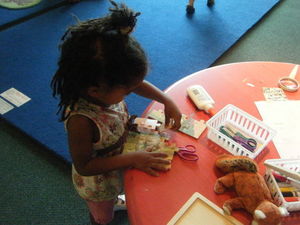As the mother of a child who has had clean and smooth dreadlocks, I have plenty of experience with this hairstyle. Ever since I was a child, I always had a fascination with dreads and had many friends who had it done. I even helped a few with the dread maintenance along the way. I have also studied many different pieces of literature on the facts about locks as well as their creation. There are many different spellings for this hairstyle, but they are all the same thing. I will refer to only one spelling to avoid confusion. Now, I will take you on the journey to clean, smooth dreadlocks.
When my 3 year old started to become overwhelmed each day at hair combing time, I decided it was time for a style that involved no combing. The only permanent one is, of course, dreadlocks. There are braids, but that would involve having to take them out and comb her hair eventually and she would not like that, so I opted for the dreadlocks, as she is very tenderheaded.
You really can have nice clean, smooth dreadlocks, no matter your hair texture. Even those with straight or fine hair can achieve dreadlocks. It does not matter how thick, thin, curly, or straight your hair is. With these simple methods, your locks will form in no time. The term “partner” will refer to the person who is creating the dreadlocks on someone else’s head. Receiver will refer to the person who is getting the dreadlocks.
Materials:
Sea Salt
water (purified works best, if you can use it)
24 ounce spray bottle
Clarifying Shampoo
Vinegar
Baking Soda
Beeswax
Rat Tail Comb
Small Black Rubber bands
willing and patient partner
Directions
Part 1: The Cleanse
Before starting your dreadlocks, you will need to thoroughly cleanse the hair. The receiver can do this cleanse or the partner may wish to do this. It is up to the two participants who will do this task. To do this cleanse, you will need baking soda, vinegar, and clarifying shampoo. Do not use conditioner. The hair will need to be dry and not oily in order for the dreadlocks to form correctly. They will slip out easily if the hair is conditioned or too soft. Do not worry. This process will not damage the hair. It just prepares the hair for the locking process.
First, you will need to thoroughly wet the hair. Next, place a small palm full of baking soda into one hand. Wet it slightly with water. Rub both hands together and then place the baking soda into hair, rubbing it all over the hair and scalp. This will scrub away any unseen buildup or grime from the hair and scalp. Once this is done, rinse the baking soda out with a half & half mix of vinegar nad water. This may cause a bit of bubbling action, but that is the goal. This will bring the dirt to the surface.
Once the bubbling has stopped, rinse thoroughly with water, until you can no longer feel any baking soda residue. Next, shampoo with the clarifying shampoo, following the directions on the bottle. This will pick up anything that was not rinsed out by the water. You can do this twice if necessary. Towel dry the hair, leaving it damp, but not dripping. The hair can stay wet for sectioning.
Part 2: Sectioning
To section off the hair, you will need a partner’s help, if you are the receiver. If you are the partner, the sectioning is your job. The hair needs to be parted in lots of small squared sections. It should be done evenly. The size of the sections will depend on how many inches around you want the dreadlocks to be. If you want them to be 1/2 inch in diameter, you will need to create 1/4 inch sections. Whatever size your sections are, the dreadlocks will be twice that size when they are fully formed, so watch the sizing closely.
Once you create each section, secure it tightly with a small black rubberband. When you have sectioned off the entire head, allow time for the hair to dry, if it is still damp. Part 3 must be done with dry hair. Some people choose to take a break at this moment or even wait until the next day for the following tasks, as they are time-consuming.
Part 3: Back Combing
Back Combing is similar to teasing the hair. It is time-consuming, so make sure the partner is ready for this and both the partner and the receiver are comfortable. It may take up to 15 minutes or more for each dread, depending on how quickly the partner can back comb. Some will get it done sooner. Be sure that the hair has dried before starting this. It will only work properly on dry, untreated hair. Do not place any products on the hair.
Place the rat tail comb about 1/4 inch from the top of the section you are starting with. I find it easier to place all the sections into a rubberband on the top of the head and pull one out as I need it. Starting from the bottom and working up and then once getting to the middle, working from the bottom of the sides on up to the top has been the easiest method. With the comb 1/4 inch from the top, comb the hair toward the scalp, rather than away from it. You are essentially creating a large knot. Continue at 1/4 inch away until the hair will no longer move. Move down 1/4 inch more. Keep up this process until you have done this to the entire section and you cannot knot it any further. If there are loose ends, gather them up.
Then, with the whole ball you just created, place it in between both palms and rub vigorously back and forth to entangle it together further and create somewhat of a rod shape. Do this until no loose ends hang out more than 1/4 inch. Now, you can move on to the next step, if you choose. Depending upon the individual, some may opt to backcomb the entire head or to move onto the next step one dread at a time. Either method is fine, as long as the dreads do not tangle with each other.
Part 4: Twisting
Twisting the dread is easy, but does require patience because this has to be done very tightly and it has to be done to every single dreadlock, one at a time. Count on about 5 – 10 minutes of twisting per dread. First, grab the top of the dread in between your thumb and forefinger. Roll it in one direction. Move down further and keep up this process until the dread is so tight it cannot twist any further without folding up into itself. While you are twisting, you’ll also need to be doing part 5 at the same time.
Part 5: Beeswax Application
During the twisting process, you will need to apply beeswax to each dread. Be generous with the beeswax. Unless your dread is looking like a wax strand and is filmy, you do not have too much. Put a small amount of beeswax between your thumb and forefinger. Rub them together. Now, while twisting the dread, wipe this beeswax into the twist as you go down it. Once the twist is complete, re-twist it, with a bit more beeswax.
Part 6: Spraying and Re-twisting
Once all of the dreadlocks have been twisted, you will need to spray them with a locking solution. With much trial and error with the many marketed products, we have found that 2 tablespoons of sea salt to 24 ounces of water works best. Iodized salt does not work as well and creates a white film, that is left behind on the dreadlocks. Always use sea salt. Place those ingredients in a spray bottle. Then, shake it vigorously. Warm water seems to work best for the initial mixing.
Once your spray has mixed together, spray the dreadlocks generously all over the head. First, spray all over the top, sides, and bottom. Then hold the head upside down, spraying underneath as well. Blot with a towel to contain dripping, but do not dry completely. Let them air dry as you re-twist them. It is not necessary to reapply beeswax here, as there is still plenty to hold the twist together.
Part 7: Maintenance
Maintenance is a key factor in keeping those dreads looking smooth and unmatted. The basics of maintenance should include a modified regimen of the cleansing, twisting, and spraying. You can read my advice on maintenance for smooth, clean looking locks here: http://voices.yahoo.com/caring-dreadlocks-maintainance-keep-smooth-446183.html
Please be advised that the author is neither a hairstylist, nor a medical professional. Please contact your physician as well as your hair stylist for advice and information that will be safe for you. Each person’s results may vary. Neither the author, nor the venue where this is published, is responsible for any damage, injury, or circumstance that happens resulting from the advice contained herein. It is best to contact the appropriate professionals before starting a new hair care regimen.
Related:
Caring for Your Dreadlocks: Maintenance to Keep Smooth Clean Locks
Dreadlock Care: What If I No Longer Want My Dreadlocks?




